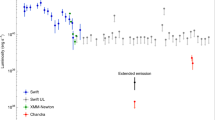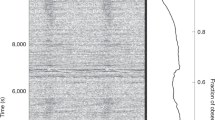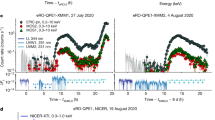Abstract
VERY condensed stars have been suggested as sources of celestial X-rays1,2 and pulsar radio emission3. The fact that the pulsar CP 0950 (ref. 4) falls within the uncertainty in the position of the X-ray source Leo XR-1 (ref. 5) could be significant and the discovery of a pulsar in the centre of the Crab nebula, a strong X-ray source, is particularly interesting although the X-rays have been shown6 to arise from a somewhat extended region. The distribution of pulsars and X-ray sources in galactic latitude, however, is very dissimilar. This lack of correlation could occur if the dense stars, which we assume hypothetically to be responsible for both types of object, were very common, and were confined to the galactic plane. If the pulsar phenomenon were much more prevalent than the X-ray phenomenon then, on the average, more-distant stars would be seen as X-ray objects and their distribution would appear to be much more closely confined to the galactic plane. This argument would also depend on the distance to which we are capable of detecting each type of object. The distances that have commonly been deduced for pulsars are sufficiently small that if a bremsstrahlung source similar to currently observed X-ray stars were present, it should be seen as an optical object, which is not the case.
This is a preview of subscription content, access via your institution
Access options
Subscribe to this journal
Receive 51 print issues and online access
$199.00 per year
only $3.90 per issue
Buy this article
- Purchase on Springer Link
- Instant access to full article PDF
Prices may be subject to local taxes which are calculated during checkout
Similar content being viewed by others
References
Morton, D. C., Ann. d'Astrophys., 27, 813 (1964).
Shklovsky, I. S., Astrophys. J., 148, L1 (1967).
Durney, B. R., Faulkner, J., Gribbin, J. R., and Roxburgh, I. W., Nature, 219, 20 (1968).
Turtle, A. J., and Vaughan, A. E., Nature, 219, 845 (1968).
Friedman, H., Byram, E. T., and Chubb, T. A., Science, 156, 374 (1967).
Bowyer, S., Byram, E. T., Chubb, T. A., and Friedman, H., Science, 146, 912 (1964).
Habing, H. J., and Pottasch, S. R., Nature, 219, 1137 (1968).
de Jager, G., Lyne, A. G., Pointon, L., and Ponsonby, J. E. B., Nature, 220, 128 (1968).
Spitzer, jun., L., and Tomasko, M. G., Astrophys. J., 152, 971 (1968).
Spitzer, jun., L., Astrophys. J., 124, 20 (1956).
Henry, R. C., Fritz, G., Meekins, J. F., Friedman, H., and Byram, E. T., Astrophys. J., 153, L11 (1968).
Shuter, W. L. H., Venugopal, V. R., and Mahoney, M. J., Nature, 220, 356 (1968).
Jenkins, E. B., and Morton, D. C., Nature, 215, 1257 (1967).
Bowyer, C. S., Field, G. B., and Mack, J. E., Nature, 217, 32 (1968).
Large, M. I., Vaughan, A. E., and Mills, B. Y., Nature, 220, 340 (1968).
Lawrence, G. M., Ostriker, J. P., and Hesser, J. E., Astrophys. J., 148, L161 (1967).
Westphal, J. A., Sandage, A., and Kristian, J., Astrophys. J., 154, 139 (1968).
Israel, W., Nature, 218, 1235 (1968).
Fritz, G., Meekins, J. F., Henry, R. C., Byram, E. T., and Friedman, H., Astrophys. J., 153, L199 (1968).
Bendat, J. S., and Piersol, A. G., Measurement and Analysis of Random Data, 278 (Wiley, New York, 1966).
Drake, F. D., and Craft, jun., H. D., Nature, 220, 231 (1968).
Andrew, B. H., and Purton, C. R., Nature, 218, 855 (1968).
Author information
Authors and Affiliations
Rights and permissions
About this article
Cite this article
FRIEDMAN, H., FRITZ, G., HENRY, R. et al. Absence of Pulsar Characteristics in Several X-ray Sources. Nature 221, 345–347 (1969). https://doi.org/10.1038/221345a0
Received:
Issue Date:
DOI: https://doi.org/10.1038/221345a0
This article is cited by
-
Sco X-1
Space Science Reviews (1977)
-
Celestial binary X-ray sources
Space Science Reviews (1976)
-
Fluctuations in the X-ray Intensity of Sco X-1
Nature Physical Science (1972)
-
Upper Limits on Pulsations from Cyg X-1 in Hard X-Rays
Nature Physical Science (1971)
Comments
By submitting a comment you agree to abide by our Terms and Community Guidelines. If you find something abusive or that does not comply with our terms or guidelines please flag it as inappropriate.



